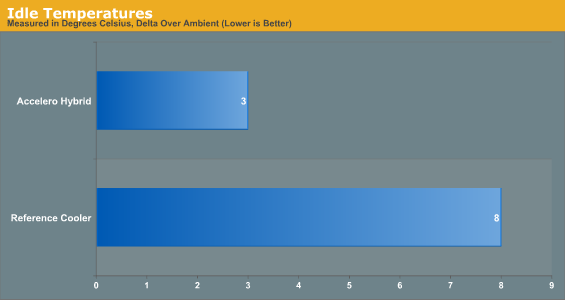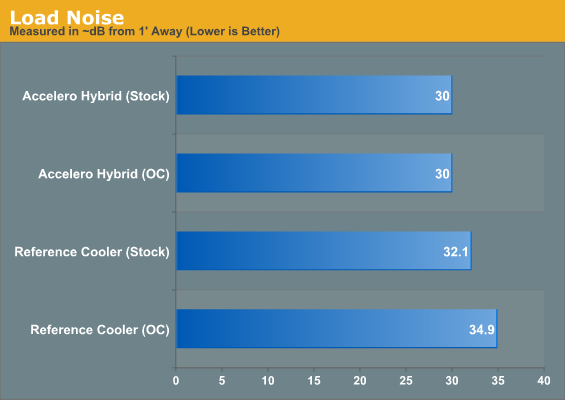Arctic Cooling Accelero Hybrid VGA Cooler Review: Not For the Faint of Heart
by Dustin Sklavos on December 28, 2012 8:15 PM EST- Posted in
- Arctic Cooling
- graphics
- cooling
Performance Results
Of course, for the Arctic Cooling Accelero Hybrid, the proof is in the testing. Once I was satisfied that I hadn't bricked the GeForce GTX 680 during assembly, I went about testing it in eVGA's OC Scanner X software. I've actually been pretty happy with OC Scanner X in personal use, and it generates enough heat to give the coolers a good workout.
I will say that what I found in testing, while not necessarily unexpected, was still pretty impressive.
Ambient temperature during testing was ~21C.

Unsurprisingly, idle temperatures are pretty impressively low for both cooling systems, but already the Accelero Hybrid is able to produce a substantially better result well outside of the margin of error.

Once a load is applied to the card, though, all bets are off. The Accelero Hybrid blows past the reference cooler, producing a massive reduction in thermals. Keep this in mind, I'm going to come back to it later.

Since the reference cooler and Accelero Hybrid both idle below the 30dB floor of our sound meter, idle noise results aren't listed. What's impressive is that the Hybrid is almost dead silent under load, regardless of the increased pressure applied to the cooling system. So while the reference cooler gets louder the harder you push the card, the Hybrid seems to have plenty of thermal headroom to spare.
Using the Arctic Cooling Accelero Hybrid on the GTX 680 has also revealed another interesting wrinkle. While overclocking on the GTX 680 is mostly limited by the Power Target, the reference cooler definitely introduces some thermal limitations. I've seen the GPU clock of the 680 take a step back and begin to throttle a little once it goes north of 70C, but because the Accelero Hybrid has so much thermal headroom, that throttling almost never happens. With the fan control manually maxed out at 85%, I registered a noise level of just 31.3dB in testing, but have actually been able to push the 680 north of 1.3GHz. The stable 6.6GHz clock on the GDDR5 has been consistent between the reference cooler and the Hybrid, but the added headroom for the GPU has allowed me to move past the ~1.2GHz I was able to attain on the stock cooling.
As I've been writing this review, I've actually been steadily testing overclocking on the GTX 680 plus Hybrid by incrementing the GPU Offset +10MHz, running it through OC Scanner X for fifteen minutes (and accepting no artifacts), then benchmarking it in 3DMark 11's Extreme test. This is by no means a thorough stability test, but it's a decent way to poke around the edges of the card's tolerances. I can't imagine how much hotter and louder it would be running with the reference cooler, but with the Hybrid at 85% it's peaking at 63C. That's at 1.3GHz, sustained load.










47 Comments
View All Comments
DanNeely - Saturday, December 29, 2012 - link
They didn't. You did by not reading much of the article before snarking. Look at the second picture on page 2 of the article. The radiator is detached and can go in any standard 120mm fan mount; the shroud attached to the card is to direct air onto the heatsinks covering the ram and VRM chips.funguseater - Saturday, December 29, 2012 - link
Absolute garbage.Been using a $49 Antec Kuhler 620 on my GTX480's overclocked to 850MHz core and they NEVER break 73 degrees. Bought a $8 custom fan bracket for mine but first just used zip-ties, and this is a GTX480 the Hottest girl on the block. This thing is so overpriced it is ridiculous. Wish I had access to an accelero to compare system cooling results but the cheapo kuhler 620 will fit any GPU cooling need.
AnnihilatorX - Saturday, December 29, 2012 - link
I wish GPU vendors offer more GPUs with waterblocks on them pre-built. Sometimes one or two vendors offer them but usually at a premium more expensive than buying a VGA card with standard cooler and the waterblock separately, which doesn't make much sense given the GPU doesn't need a standard cooler and sink anymore.I hate GPU fan noise and I hate thorttling, although I don't OC much I found watercooling is worth it. However last time I was careless with the VRM cooling on the HD6950, the VRM size is so small and hard to cool without specially made waterblock. I went DIY route and got the card burnt out, $400 down the drain for me lol
funguseater - Saturday, December 29, 2012 - link
Yeah, thats why when I use a sealed CPU unit like the H70 or Kuhler 620 I just leave the stock blower fan and heatsink on, you can just leave the fan at a solid 40% and never hear it, and it cools your VRM just as well as stock. The CPU cooler just bolts ontop of the card all you do is remove the "heatpipe section" and replace with the sealed cooler, whamo 30degree drop under load. YMMV, laser cut steel adapters with fan mounts can be found online if you don't use a reference model GPU.CaedenV - Saturday, December 29, 2012 - link
I put an AC cooler on my old 9800GT back in the day. It went from sounding like a vacuum cleaner with the stock cooler, to dead silent with a passive radiator, while keeping the load temp 15*c cooler. It was unbelievable.Only problem was that they used cheap thermal tape to keep the ram heat-sinks attached, and every once in a while one would fall off, causing really annoying problems until I would reattach it. A few months later another would fall off, etc etc, and it was that way until I finally upgraded. But other than that it was perfect.
jonjonjonj - Sunday, December 30, 2012 - link
At that price it's not worth it. Especially when you add a h100 your looking at $300. You could build a custom loop for the price of just the article cooler. Add that it's not a simple bolt on like the CPU version and it doesn't make a whole lot of sense. It actually just looks like they took the CPU version and strapped it into a plastic gpu case. I think they need to go back to the drawing boards and design the gpu cooler from the ground up. Not just slap the CPU cooler on a gpu.TekDemon - Sunday, December 30, 2012 - link
Buying one of these is rather pointless unless you're going to overvolt the GPU...So...anandtech...where's my sweet overvolted charts? =p
mi1stormilst - Wednesday, January 2, 2013 - link
get a higher end card than the one you planned on getting and avoid all this headache from the get go ;-Pwoogitboogity - Wednesday, January 2, 2013 - link
"Not for the faint of heart" kind of says it all. I was burned BAD by liquid cooling 4 years ago and to be fair I did bring it on myself given the circumstances. Back then there were a few companies exploring a middle ground beyond the "old car radiator" DIY types with actual purpose built components that were supposed to fit together based on pre-existing on water hoses used in labs. Still despite how much it cost me in the end, I will not deny that having my North Bridge, CPU and Graphics Hardware running a few degrees over ambient at full load was downright intoxicating for as long as it ran. It then made a mockery of what I thought was a reasonably watertight seal. The fact that what they sell now are all closed loop cycles with pump and heat sink already integral parts out of the box is absolutely no surprise to me and I expect it to stay that way for good reason. Also, when you start doing funny stuff with memory heat sinks you sometimes have to add clear paste to protect the contacts on the board from weird impedance changing effects from the thermal conductive paste and the copper block itself. I wonder whether this was also a factor as well in bricking half the hardware I had installed on my ill-fated PC.If you have money to burn, or to be more accurate, money to replace what is burned out, then go for it. But make no mistake that you are as off-warranty as off-warranty gets. I know the product offerings are safer and have come a long way but newer electronics that are 10 times as fast can be a 1000 times more delicate. For myself, I work with fairly advanced electronics in high energy physics, so I do not say it lightly that I will not touch the innards on anything from a nice Workstation/Desktop. Not unless it is already broken, for the purposes of seeing if I can fix it to beef up a machine I don't care that much about.
Nice article though, despite the difficult memories it brought up of finding a water puddle in my case. :-)
stoatwblr - Wednesday, March 19, 2014 - link
Moisture detectors are fairly readily available and can be rigged to cut the power.(contaminated) Water on unenergised circuitry is fairly benign. Just wash it off.